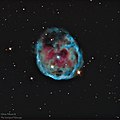NGC 246 (also known as the Skull Nebula[5] or Caldwell 56) is a planetary nebula in the constellation Cetus. It was discovered in 1785 by William Herschel. The nebula and the stars associated with it are listed in several catalogs, as summarized by the SIMBAD database.[1]
The nebula is roughly 3,500+720
−850 light-years away.[2] NGC 246's central star is the 12th magnitude[7] white dwarf HIP 3678 A.[8] In 2014, astronomers discovered a second companion to NGC 246's central star, which has a comoving companion star called HIP 3678 B. The second companion star, a red dwarf known as HIP 3678 C, was discovered using the European Southern Observatory's Very Large Telescope. This makes NGC 246 the first planetary nebula to have a hierarchical triple star system at its center.[9]
NGC 246 is not to be confused with the Rosette Nebula (NGC 2337), which is also referred to as the "Skull."[10] Among some amateur astronomers, NGC 246 is known as the "Pac-Man Nebula" because of the arrangement of its central stars and the surrounding star field.[6]
Image gallery
-
HaRGB image of The Skull Nebula (NGC 246). Data from the Liverpool Telescope, processed by Göran Nilsson. Total exposure time 1.1 hours.
-
NGC 246 acquired using the Schulman 0.8m Telescope atop Mount Lemmon, AZ. This is a full color (visual) image.
References
- ^ a b c d e "NGC 246". SIMBAD. Centre de données astronomiques de Strasbourg. Retrieved 2006-12-22.
- ^ a b Löbling, Lisa (2018-06-01). "Sliding along the Eddington Limit—Heavy-Weight Central Stars of Planetary Nebulae". Galaxies. 6 (2): 65. arXiv:1806.07279. Bibcode:2018Galax...6...65L. doi:10.3390/galaxies6020065.
- ^ a b "SEDS NGC Catalog Online". Results for NGC 246. Retrieved 2010-11-29.
- ^ "NGC 246". Astronomy: Stars & Planets. Retrieved 2013-01-07.
- ^ a b "The Night Sky", Astronomy Now, Oct 2008.
- ^ a b David H. Levy, Deep Sky Objects, Prometheus Books, 2005, ISBN 1-59102-361-0, p 129.
- ^ Stephen James O'Meara, The Caldwell Objects, Sky Publishing Corporation, ISBN 0-933346-97-2, p 223.
- ^ Adam, C.; Mugrauer, M. (2014-11-01). "HIP 3678: a hierarchical triple stellar system in the centre of the planetary nebula NGC 246". Monthly Notices of the Royal Astronomical Society. 444 (4): 3459–3465. arXiv:1409.5339. Bibcode:2014MNRAS.444.3459A. doi:10.1093/mnras/stu1677. ISSN 0035-8711.
- ^ information@eso.org. "Stars and Skulls: new ESO image reveals eerie nebula". www.eso.org. Retrieved 2023-03-09.
- ^ "A hole in the heart of the Rosette Nebula". CNN. 14 February 2018.
External links
 Media related to NGC 246 at Wikimedia Commons
Media related to NGC 246 at Wikimedia Commons- NGC 246 on WikiSky: DSS2, SDSS, GALEX, IRAS, Hydrogen α, X-Ray, Astrophoto, Sky Map, Articles and images










